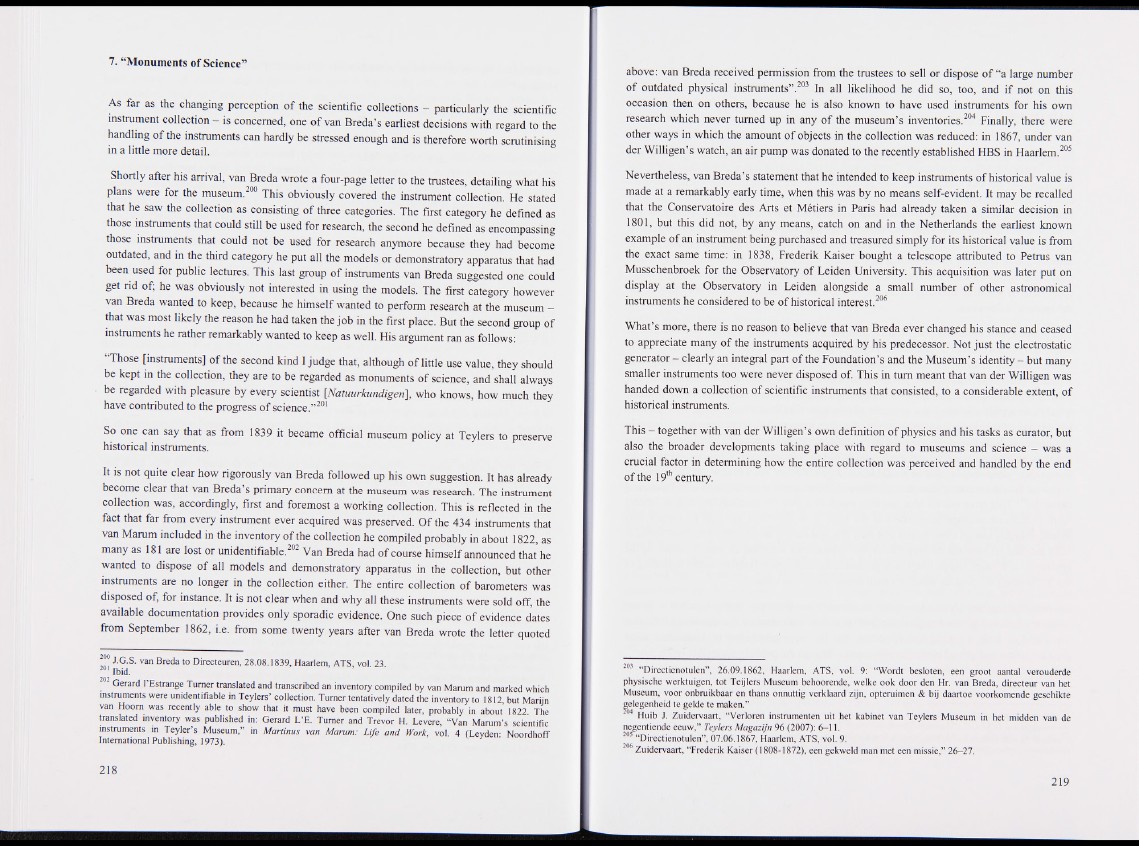
7. “Monuments of Science”
As far as the changing perception of the scientific collections - particularly the scientific
instrument collection - is concerned, one of van Breda’s earliest decisions with regard to the
handling of the instruments can hardly be stressed enough and is therefore worth scrutinising
in a little more detail.
Shortly after his arrival, van Breda wrote a four-page letter to the trustees, detailing what his
plans were for the museum.200 This obviously covered the instrument collection. He stated
that he saw the collection as consisting of three categories. The first category he defined as
those instruments that could still be used for research, the second he defined as encompassing
those instruments that could not be used for research anymore because they had become
outdated, and in the third category he put all the models or demonstratory apparatus that had
been used for public lectures. This last group of instruments van Breda suggested one could
get rid of; he was obviously not interested in using the models. The first category however
van Breda wanted to keep, because he himself wanted to perform research at the museum -
that was most likely the reason he had taken the job in the first place. But the second group of
instruments he rather remarkably wanted to keep as well. His argument ran as follows:
“Those [instruments] of the second kind I judge that, although of little use value, they should
be kept in the collection, they are to be regarded as monuments of science, and shall always
be regarded with pleasure by every scientist [Natuurkundigen], who knows, how much they
have contributed to the progress of science.”201
So one can say that as from 1839 it became official museum policy at Teylers to preserve
historical instruments.
It is not quite clear how rigorously van Breda followed up his own suggestion. It has already
become clear that van Breda’s primary concern at the museum was research. The instrument
collection was, accordingly, first and foremost a working collection. This is reflected in the
fact that far from every instrument ever acquired was preserved. Of the 434 instruments that
van Marum included in the inventory of the collection he compiled probably in about 1822, as
many as 181 are lost or unidentifiable.202 Van Breda had of course himself announced that he
wanted to dispose of all models and demonstratory apparatus in the collection, but other
instruments are no longer in the collection either. The entire collection of barometers was
disposed of, for instance. It is not clear when and why all these instruments were sold off, the
available documentation provides only sporadic evidence. One such piece of evidence dates
from September 1862, i.e. from some twenty years after van Breda wrote the letter quoted
J.G.S. van Breda to Directeuren, 28.08.1839, Haarlem, ATS vol 23
201 Ibid.
Gerard l’Estrange Turner translated and transcribed an inventory compiled by van Marum and marked which
instruments were unidentifiable in Teylers’ collection. Turner tentatively dated the inventory to 1812, but Marijn
van Hoorn was recently able to show that it must have been compiled later, probably in about 1822. The
translated inventory was published in: Gerard L ’E. Turner and Trevor H. Levere, “Van Marum’s scientific
instruments in Teyler’s Museum,” in Martinus van Marum: Life and Work, vol. 4 (Leyden- Noordhoff
International Publishing, 1973).
above: van Breda received permission from the trustees to sell or dispose of “a large number
of outdated physical instruments”.203 In all likelihood he did so, too, and if not on this
occasion then on others, because he is also known to have used instruments for his own
research which never turned up in any of the museum’s inventories.204 Finally, there were
other ways in which the amount of objects in the collection was reduced: in 1867, under van
der Willigen’s watch, an air pump was donated to the recently established HBS in Haarlem.205
Nevertheless, van Breda’s statement that he intended to keep instruments of historical value is
made at a remarkably early time, when this was by no means self-evident. It may be recalled
that the Conservatoire des Arts et Métiers in Paris had already taken a similar decision in
1801, but this did not, by any means, catch on and in the Netherlands the earliest known
example of an instmment being purchased and treasured simply for its historical value is from
the exact same time: in 1838, Frederik Kaiser bought a telescope attributed to Petrus van
Musschenbroek for the Observatory of Leiden University. This acquisition was later put on
display at the Observatory in Leiden alongside a small number of other astronomical
instruments he considered to be of historical interest.206
What’s more, there is no reason to believe that van Breda ever changed his stance and ceased
to appreciate many of the instruments acquired by his predecessor. Not just the electrostatic
generator - clearly an integral part of the Foundation’s and the Museum’s identity - but many
smaller instruments too were never disposed of. This in turn meant that van der Willigen was
handed down a collection of scientific instruments that consisted, to a considerable extent, of
historical instruments.
This - together with van der Willigen’s own definition of physics and his tasks as curator, but
also the broader developments taking place with regard to museums and science — was a
crucial factor in determining how the entire collection was perceived and handled by the end
of the 19th century.
203 “Directienotulen”, 26.09.1862, Haarlem, ATS, vol. 9: “Wordt besloten, een groot aantal verouderde
physische werktuigen, tot Teijlers Museum behoorende, welke ook door den Hr. van Breda, directeur van het
Museum, voor onbruikbaar en thans onnuttig verklaard zijn, opteruimen & bij daartoe voorkomende geschikte
^elegenheid te gelde te maken.”
04 Huib J. Zuidervaart, “Verloren instrumenten uit het kabinet van Teylers Museum in het midden van de
negentiende eeuw,” Teylers Magazijn 96 (2007): 6-11.
205 “Directienotulen”, 07.06.1867, Haarlem, ATS, vol. 9.
206 Zuidervaart, “Frederik Kaiser (1808-1872), een gekweld man met een missie,” 26-27.